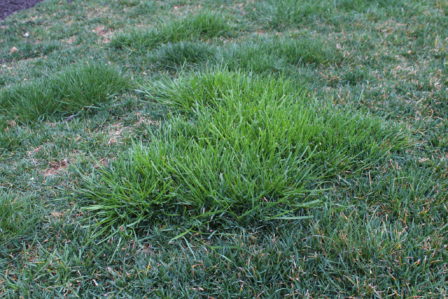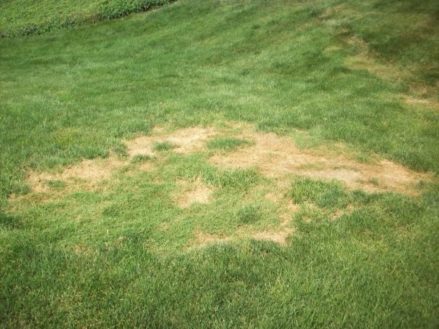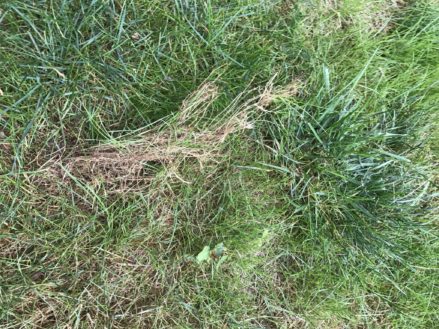Tuesday, April 30, 2019
Why Does My Lawn Look Patchy? – Rough Bluegrass
One of the most common calls we get throughout the season is about “patchy” looking lawns. These calls can come from current clients or potential new clients. Rough bluegrass isn’t picky about whether you have lawn care or not.
 Background
Background
Rough bluegrass (poa trivialis) is native to Eurasia. This makes it a non-native, invasive species here in North America. It was likely brought to the US by early settlers for use in pastures and marshy areas.
Rough bluegrass is in the same family as Kentucky bluegrass, but grows differently. Kentucky bluegrass spreads by rhizomes (it puts out shoots underground). Rough bluegrass spreads through stolons (it puts out shoots over the top of the ground). Stoloniferous grasses tend to grow and spread more aggressively, like Bermuda, zoysia, or St. Augustine grasses do. This means that, under the right growing conditions, rough bluegrass will spread much more quickly than our native grasses, and can overtake portions of the lawn. This “crowding out” of native grasses is what causes rough bluegrass to look like there are these patches throughout the lawn.
What to look for
Poa trivialis grows best under very specific conditions. It grows most aggressively when the weather is cooler and damp. Soils with lots of moisture tend to be the places that you’ll see the largest strands of this grass. Because poa trivialis prefers that moisture, you’ll also most likely find it growing in parts of your lawn with shade.
Rough bluegrass doesn’t do very well with drought stress or heavy traffic. When the summer heat starts to arrive, and you’re actually using your lawn more often, that’s when these calls really begin in earnest. The higher temperatures combined with the foot traffic often make a patch of poa trivialis look like a turf disease or grub damaged lawn.
Management
There are couple of different options for managing rough bluegrass in the lawn, once you’ve identified it.
Mechanical
 You have some options for mechanical (non-chemical) management.
You have some options for mechanical (non-chemical) management.
If you’ve identified poa trivialis in the lawn (when stressed, it often looks like a pile of spaghetti), you can literally rake it up when it’s cool and the soil is moist. Do your best to pull it up by the roots as you rake. Another option is to get a flat shovel or a sod-cutter and remove the plant and root system together. Again, your best bet is to do this while the soil is damp and temperatures are cooler.
According to North Carolina State University, rough bluegrass is sometimes used on putting greens. The University of California advises mowing at 1” – 2.5” in height to encourage growth of poa trivialis. Why mention it? Rough bluegrass has a tendency to mat, or lay down flat, in a lawn. The remedy for many homeowners is to simply lower the height of their lawn mower. Mowing too close to the ground may encourage rough bluegrass to spread and grow! If you’re trying to eliminate it, make sure you’re not mowing too low.
Lastly, you can limit the spread of poa trivialis by managing the amount of water it gets. When we’re experiencing drought stress, water the lawn only enough to keep native grasses healthy. The drought-susceptible rough bluegrass will quit spreading so aggressively, and native grasses will have more of a chance to compete and spread.
Chemical
Both NC State and the Pennsylvania Department of Conservation of Natural Resources (DCNR) agree chemical management is an option. (The DCNR actually considers poa trivialis an “invasive plant.”)
For large areas where rough bluegrass has established, you’ll need to carefully treat it with a non-selective herbicide. Again, caution is important; non-selective herbicides kill everything, healthy turf included. Once the desired section of turf is controlled, you should still manually remove the remaining plant material and re-seed or sod the area.
For large sections or many different sections in the same lawn, you may want to consider contracting with a professional company licensed to use these products. This ensures less chance of harm to non-target plants or the environment.
Wrap-up
Rough bluegrass or poa trivialis is a pain to deal with. It’s a non-native, invasive species that often looks awful in our lawns. Management options include culture and mechanical practices, as well as chemical treatment.
If you have questions about managing rough bluegrass in your lawn and would like to speak with a professional for a free consultation, please Contact Us.
The post Why Does My Lawn Look Patchy? – Rough Bluegrass appeared first on Tomlinson Bomberger.
from Tomlinson Bomberger http://bit.ly/2IUo1Ye
Friday, April 26, 2019
Joe Lamp’l Launches Beginning Gardening Course Online
 As a proselytizer for gardening, I’m always on the look-out for people who teach it well, and new ways they’re reaching potential students – especially ways that help pay their mortgage. (Because as we all know, paying gigs for garden communicators are drying up, as newspapers close, etc.)
As a proselytizer for gardening, I’m always on the look-out for people who teach it well, and new ways they’re reaching potential students – especially ways that help pay their mortgage. (Because as we all know, paying gigs for garden communicators are drying up, as newspapers close, etc.)
So when I noticed that Joe Lamp’l was adding paid online courses to his many educational offerings, I decided to check into it. After all, he’s been teaching millions of people for over 15 years through television, including his PBS show “Growing a Greener World” now in its 10th season. Of more recent vintage is his Podcast, one of my favorites, and with still too much apparent downtime, he’s added full-blown courses to the mix.
First up at his The Organic Academy” is a course in Beginning Gardener Fundamentals, with 10 modules of 15 to 35 minutes each covering the food-growing basics (soil, planting, raised beds, fertilizers, etc) in Joe’s usual expert yet approachable way.
The tuition is $147, and for that you also get these: how-to videos, e-books, and a Facebook Group just for students in the course, where they interact with each other and where Joe does two 1-hour FacebookLive events every week. Students have lifetime access to course info and the online mentoring community, plus updates.
With a password from Joe I logged onto the course and noticed right away the discussions below each module, with long answers by Joe and lots of back and forth. Which makes me wonder how much time the guy is devoting to this, and what kind of enrollment does it take to make the time pay off? More will be revealed.
These days there’s still a presumption that content online should be free, so what do I think about courses that aren’t? The $147 seems reasonable or actually a bargain. I’ve paid $100-$175 for one-day educational gardening events that, after all, can only teach so much in that amount of time.
I see Joe’s course as a natural addition to the growing “freemium” culture online, in which some valuable content is free and even more is available if you “go premium.” And I’m happy to see good teachers get paid for what they do.
It may surprise readers to know that despite my mission to find and promote the best free how-to-garden videos on YouTube, I’m also pleased to see video instructors like Karen Chapman and Rachel Mathews charging for outstanding instruction – because gardening channels on YouTube may never pay well enough. Which, considering the astonishing incomes some lifestyle “personalities” are earning on YouTube these days, is just sad.
So what’s free from Joe? Growing a Greener World Online and on PBS when aired; his terrific weekly Podcast (I particularly loved the episode “Catching up with Paul James”); a new video every week at JoeGardenerTV on YouTube; and the Joe Gardener Facebook group, now with over 21,000 members.
 I called Joe to find out more about his newest venture, and learned that despite his years on TV, his “real love” is digital content, where he has so much more control. Pursuing this new income stream seems smart to me because you never know when those nice PBS sponsors will decide to go elsewhere in today’s fast-changing media landscape.
I called Joe to find out more about his newest venture, and learned that despite his years on TV, his “real love” is digital content, where he has so much more control. Pursuing this new income stream seems smart to me because you never know when those nice PBS sponsors will decide to go elsewhere in today’s fast-changing media landscape.
Another income stream for Joe is working with “brand partners” like Corona, with whom he’s creating 30 short videos this year for YouTube. I urged him to do as many as possible on pruning because YouTube’s how-to-prune videos are still grossly inadequate, considering the need.
So how’s the course going? Joe said he’s been surprised by the nonbeginners who are enrolled – horticulturists and very experienced gardeners, including Harvey Cotton, director of the Huntsville Botanical Garden. Surely beginners have the most to learn from the course, and they’re using terms like “transformative” and “empowered” in their feedback.
More courses are in the works covering the challenges of organic food-gardening in greater detail.
Enrollment reopened yesterday and will stay open for a week.
Lawn Care, Anyone?
Even more popular than food-growing in the U.S. is lawn-growing, either by dumping excess resources on it or by letting it go to ruin. So I’ll close this blog post with the Joe Lamp’l organic take on lawn care.
Joe Lamp’l Launches Beginning Gardening Course Online originally appeared on GardenRant on April 26, 2019.
from GardenRant http://bit.ly/2PvB1nI
Thursday, April 25, 2019
Monday, April 22, 2019
Sunday, April 21, 2019
Thanks to NY Botanic Garden and U. Chicago Press!

Here at GardenRant we don’t use Google ads or aggressively pursue advertisers because we blog for the love of it, not to pay our mortgages. But like any website, we DO have expenses – for hosting, site maintenance and improvement.
So boy, do we ever appreciate our advertisers – like the prestigious organizations promoting books and educational opportunities on GardenRant right now. And today we interrupt our usual assortment of news, opinion, plant and people profiles and outright rants for a brief mention of our advertisers, with our thanks.
Speaking of prestigious, a New York Botanic Garden Certificate is definitely that, and can be pursued on an accelerated basis through their Summer Intensive Programs in Floral Design, Landscape Design or Gardening; intensive classes are also available in Botanical Art & Illustration and Horticultural Therapy.
If I lived closer to NYC I’d sign up for the course in Landscape Design myself. (I’m loving the class in Landscape Architecture that I’m auditing at the University of Maryland, but it’s teaching me how little I know.)

You’ll also find in our sidebar a new book about oaks from Kew Gardens, being distributed in the U.S. by the University of Chicago Press Books. They’re a long-time advertiser on GardenRant.
We’re honored by the support of such highly respected organizations.
Thanks to NY Botanic Garden and U. Chicago Press! originally appeared on GardenRant on April 21, 2019.
from GardenRant http://bit.ly/2GyGAyI
Friday, April 19, 2019
Favorite Shrubs and Ground Covers in my April Garden

Here in the Mid-Atlantic there’s plenty of blooming action among bulbs, but in my own garden I only have eyes for my newest plants, especially the ones with big job requirements – shrubs for screening and groundcovers to do the obvious.
So take this Koreanspice viburnum, for instance. (V. carlesii). It’s full-grown now in its 7th year – a nice small size for small gardens – but this year it’s in a new spot, where it provides just enough privacy between my porch and the sidewalk behind my back yard.
After its super-fragrant blooms are gone the shrub looks a bit boring but hey, it’s still doing its job, with no work on my part.

Here’s a different view of that Viburnum with blooms of a ‘Forest Pansy’ redbud in its second spring here. On the right you see the privacy screen I had built about a year ago for the purpose of blocking of an ugly view, and love it!

Here’s a closer shot of the screen with ‘Ogon’ Spireas on either side and an Oakleaf Hydrangea leafing out in the middle.

Above and below are views of the screen from the sidewalk at the rear of the back yard. Above, the ‘Rising Sun’ redbud I planted last fall, in bloom.

Here the redbud’s leaves have turned yellow (thus the name ‘Rising Sun’) and a Fothergilla is blooming. Like the Koreanspice viburnum, Fothergillas aren’t much to look at once the blooms are gone, but in this out-of-the-way location that’s fine.

Now for a couple of groundcovers, starting with golden groundsel (Packera aurea), which is evergreen, native, and a reliable spreader in shady spots. I love it in this spot where it’s far from any azaleas, which bloom at the same time and to my eyes, look terrible combined with gold blooms like these.

Another groundcover I’m forever recommending is also evergreen; it’s the old-fashioned comfrey (Symphytum grandiflorum) just starting its long bloom period. Comfrey can also handle shade and spreads reliably, so I can’t figure out why no one grows them. Or sells them, for that matter.

Here in my front garden, more comfrey is filling in quickly around the foundation shrubs. Another ‘Ogon’ Spirea is at work hiding my new mini-split HVAC, which can just barely be seen behind it. Also shown is an Osmanthus heterophyllus ‘Goshiki’ (another of my favorite shrubs of all time) and an unidentified azalea.
That’s all for now from my little Maryland garden.
Favorite Shrubs and Ground Covers in my April Garden originally appeared on GardenRant on April 17, 2019.
from GardenRant http://bit.ly/2V9RKSN
Wednesday, April 17, 2019
Tuesday, April 16, 2019
Monday, April 15, 2019
Friday, April 12, 2019
Friday, April 5, 2019
Thursday, April 4, 2019
Wednesday, April 3, 2019
Tuesday, April 2, 2019
Monday, April 1, 2019
First Lady Jill Biden and the White House Garden
Now that almost everyone concedes that the Bidens will be moving into the White House soon (hopefully, soon enough!), local garden writers ...

-
Now that almost everyone concedes that the Bidens will be moving into the White House soon (hopefully, soon enough!), local garden writers ...
-
Neither sorrow nor fear has diminished home gardening’s potential to heal during this pandemic spring. Chris Beytes of Grower Talks, the...
-
One of the most common calls we get throughout the season is about “patchy” looking lawns. These calls can come from current clients or pot...